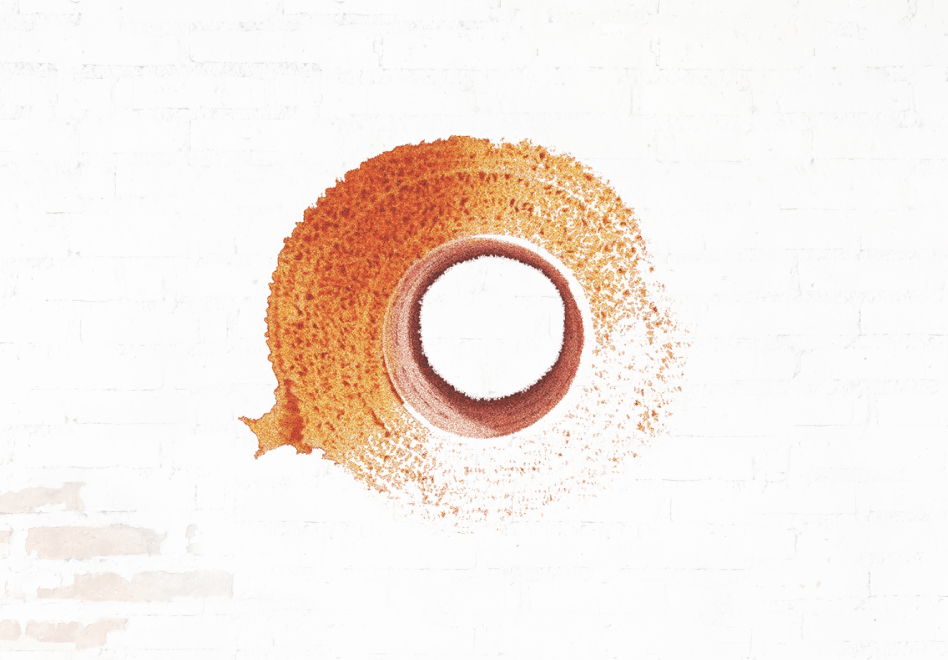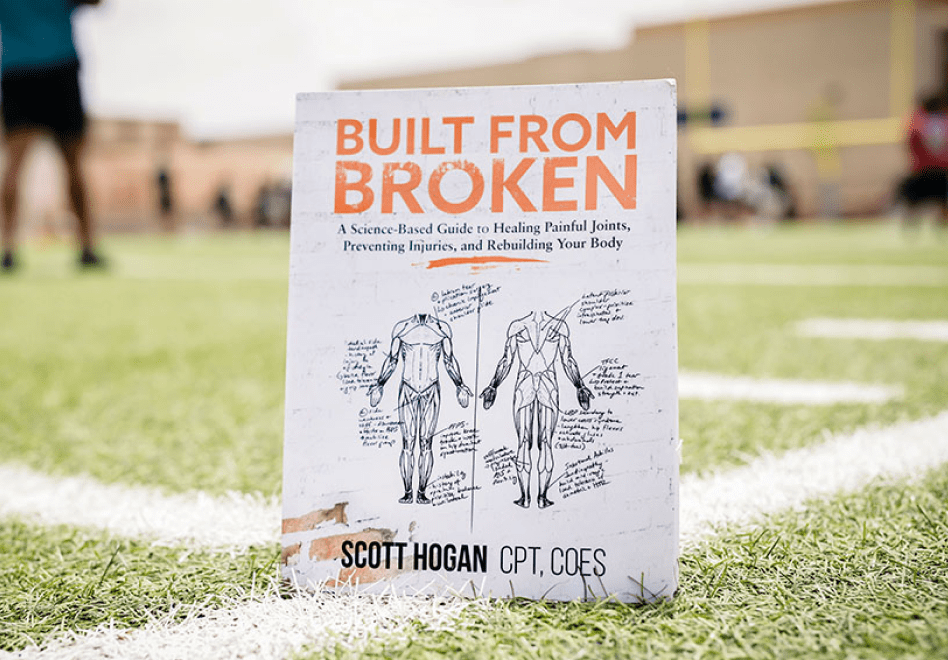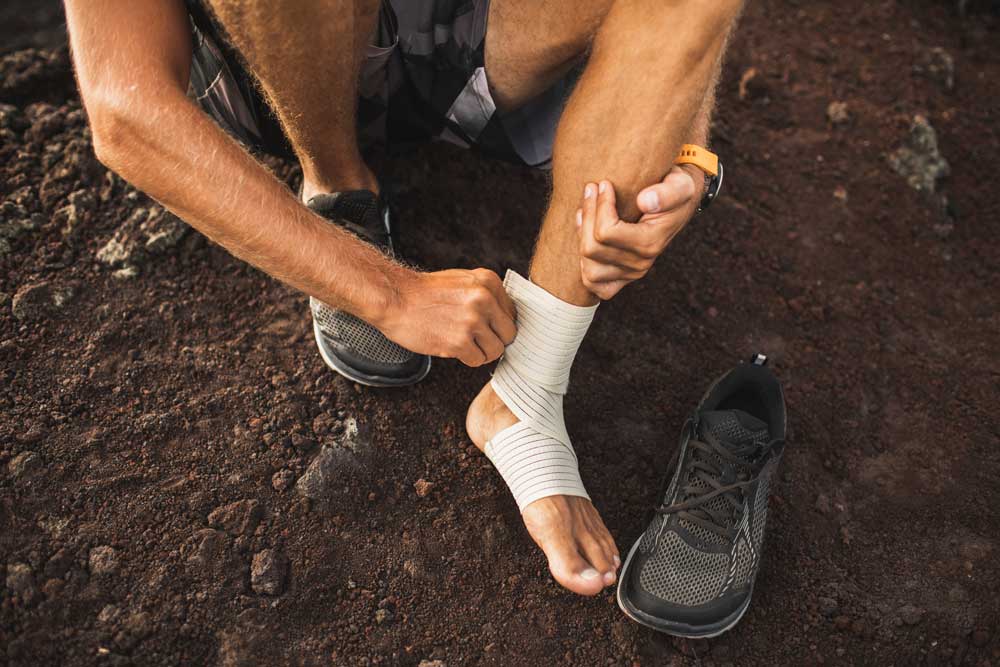
Be built (to last).
The right supplements can help you recover naturally and build a resilient body.

Supplement Quiz
Take this short quiz to discover the perfect supplements for your needs and goals.
About SaltWrap

Built from Broken
Get the best-selling book from SaltWrap founder, Scott Hogan, and start rebuilding today.
Supplements for Injury Recovery: The Definitive Guide
by Scott Hogan, ACE-CPT, COES
Athletes and Weekend Warriors depend on Non-steroidal Anti-Inflammatory Drugs (NSAIDs) like ibuprofen to manage pain and inflammation after an injury.
But long-term studies show NSAIDs do more harm than good. They interfere with the natural healing process, reduce collagen mass at injury repair sites, and increase chances of re-injury by as much as 25%.
The goods news is that we have better options when it comes to exercise related aches and pains. Research shows us that certain natural nutrients provide similar pain and inflammation relief without the negative side effects.
They bolster your body's recovery processes instead of hindering them.
We assembled this article to serve as a complete guide for supplementing your way through any strain, sprain, or case of tendinitis you come up against.
In addition to being a complete and definitive resource, we also wanted this article to be actionable.
Use the links in the Table of Contents below to help you navigate to the most relevant sections for you. In addition to listing the best injury-healing supplements, we cover:
- how NSAIDs do more harm than good for injury rehabilitation
- the three fundamental goals of supplementing for injuries
- tissue-specific injury supplementation
- the All-Star List of supplements with the most evidence for supporting injury repair
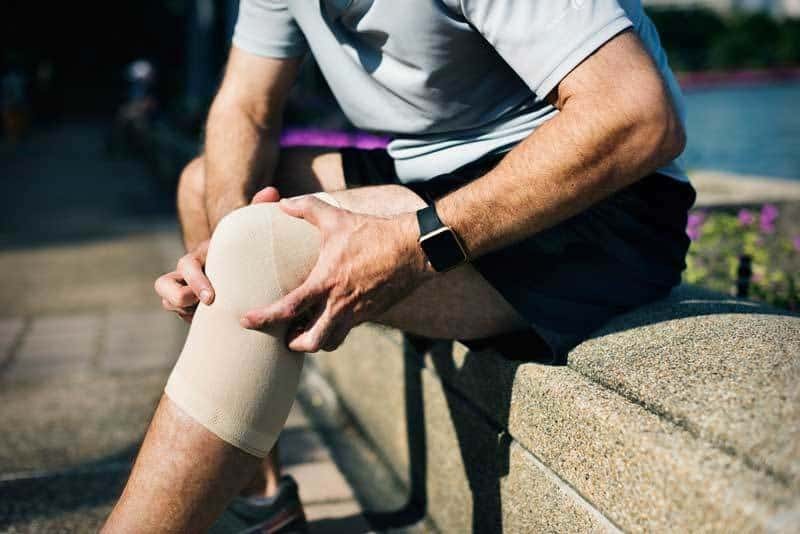
The right supplement strategy can improve injury recovery time and quality of tissue repair.
What's the first thing you do after an injury?
If you’re like most people, you pop a few ibuprofen.
And that’s probably worked well for you. More on that in a second.
Or if you’re hurt badly, you go see a doctor.
He’ll schedule you for a $3,000 MRI, then give you 3 options:
- Surgery
- Corticosteroid Injections
- Anti-inflammatory drugs
Not a very holistic approach.
But this is Conventional Medicine's standard operating procedure.
I’ve been through the process myself a dozen times.
Which is one of the primary reasons SaltWrap exists.
More often than not, I’ve had to take injury treatment into my own hands.
I’ve tried all three solutions for various injuries… corticosteroid injections and anti-inflammatory drugs did absolutely nothing for me.
And I only caved into surgery after a shoulder labral tear and detachment left my arm pretty much unusable without some mechanical fixing.
Surgery should always be the last option after no conservative treatments have worked.
Most people aren’t eager to jump under the surgeon’s knife, which is a good thing.
But virtually everyone reaches for anti-inflammatory drugs, NSAIDs, or other pain medications following an injury.
Either to get them back on the playing field, or just to relieve pain and discomfort.
And the truth is.. they work. Especially ibuprofen.
There’s a good chance that as you’re reading this, you can recall a time when you took a couple ibuprofen tablets and —“POOF” — the pain was gone.
But emerging research shows that corticosteroid injections, prescription pain medication, and even over the counter Non-Steroidal Anti-Inflammatory Drugs (NSAIDs) have poor long-term outcomes when it comes to injury rehabilitation.
In the short term, NSAIDs like ibuprofen reduce pain and improve joint function.
In the medium term, joint strength and mobility is improved with NSAID usage as they allow for a sooner-than-later return to normal activities.
But in the long term, joint integrity is damaged.
One study found that the recidivism rate (how often the injury reoccurs) was 25% higher in subjects who took NSAIDs after their injury.
We have a contradiction…
NSAIDs clearly relieve pain and reduce inflammation.
They can even help you get back to training and normal life sooner.
And in the case of a pinched nerve or excessive swelling that limits movement, they’re almost necessary.
But in the long-term, you’re selling your joints out.
One reason for this contradiction is they interfere with the inflammatory process during those first few days of an injury, impairing the body’s ability to clear damaged tissue and bring fresh nutrients to the injury site.
This leads to reduced collagen mass in the injured joints, and weaker tissue formations that are more prone to re-injury.
Not to mention, the use of NSAIDs increases risk of heart failure and damages your gut lining.
It’s a clear trade off.
Here’s how we recommend handling this conundrum:
Best Practices for NSAID Usage
- If you must, opt for pain relievers like acetaminophen (Tylenol®) instead of anti-inflammatories like ibuprofen (Advil®) and naproxen (Aleve®) during the first 7 days post-injury.
- Use NSAIDs and prescription anti-inflammatories only as necessary to relieve (unbearable) pain and excessive inflammation. Remember that we need inflammation to heal injuries. Use them for 3-7 days if necessary, then get off (see #4).
- If at all possible, get through the first 7 days of your injury without taking NSAIDs or prescription pain pills. This will allow the inflammation process to run naturally, clean up dead tissue, and bring fresh nutrients to repair the injury.
- Best option: Use the supplements below to help manage inflammation and pain, while also supporting long-term recovery outcomes. You can use these as your first line of defense or switch from NSAIDs to these natural supplements after the pain starts to subside.
How to Optimize Injury Recovery with Supplements (Instead of Drugs)
We talked about this in our injury recovery guide, but often times what separates people who continually progress toward their fitness goals (from those who don’t) is how good they are at recovering from minor injuries.
Some of this is genetic. Certain people have quick-healing tendons and ligaments.
But there’s quite a bit that is under your control.
Here are some of the factors that influence injury recovery timelines and quality of injury repair that you have direct control over:
- Rest
- Physical therapy
- Nutrition (e.g. consuming plenty of water and adequate protein)
- Stress
While rest and physical therapy are the two most impactful components, nutrition is the most underrated variable. Here’s why:
- Even slight dehydration can reduce blood flow and nutrient delivery to injured tissues, impairing the healing process.
- Lack of adequate calories or protein can slow down muscle protein synthesis, an important outcome for getting back to full function.
- Consuming junk food that causes excess mineral excretion, raises inflammation levels, and produces free radicals could cause more damage to your injured tissues.
These are the basics of nutrition for injury recovery.
And their importance shouldn’t be discounted.
But research indicates that the right nutritional supplement strategy can positively impact not only the timeliness of your recovery, but the quality of tissue formations as well.
Just like how you can optimize recovery from weight training to repair microscopic trauma to muscles, you can do the same for your tendons, ligaments, and cartilage when they’re damaged.
While everyone is obsessed over pre-workout and post-workout nutrition to build stronger muscles — few give “injury nutrition” the consideration it deserves.
The first few weeks are especially crucial while your body begins the clean up and remodeling process, clearing away dead cells and building new ones.
When it comes to injury recovery, time is definitively of the essence.
If you fail to eat and supplement properly, you aren’t just prolonging recovery time, you’re setting yourself up for injury recurrence and weak tissue formations that could plague you for a lifetime.
This is largely due to how the tissue granulation process affects your range of motion and joint integrity.
If you have a nagging joint that always seems to be your weakest link, this is likely part of the problem.
And the right supplements can help prevent this problem.
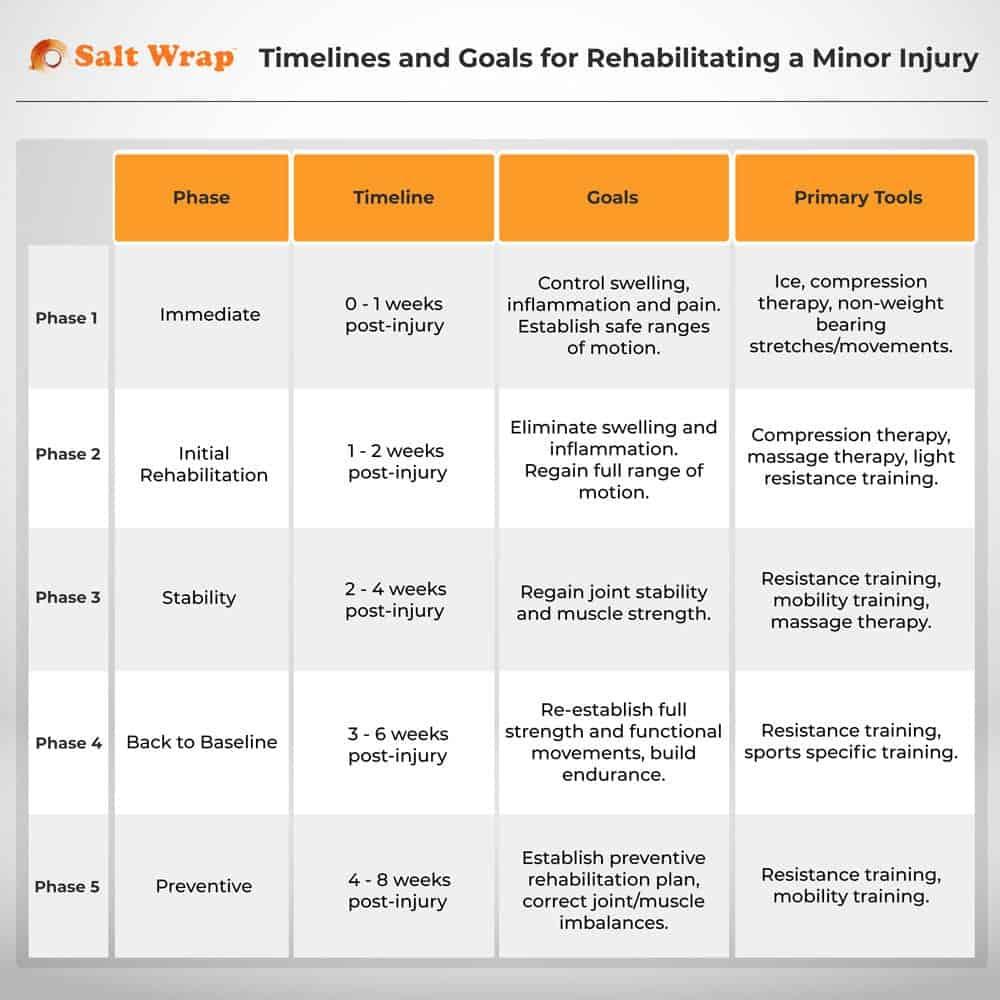
The first 6 weeks after an injury is a crucial time period for building healthy connective tissue and getting back to pain-free ranges of motion.
We’ve taken a special interest in nutrition for injury recovery.
Isolating the most important biological processes for tissue repair, hunting down proven supplements for injury recovery, and finding ways to integrate those into our clients’ recovery protocols.
This has become a big part of our exercise therapy and training practice.
Now, I’m not claiming that taking fish oil or curcumin is going to magically repair a torn rotator cuff.
But the right nutritional supplement approach — especially when combined with the right physical therapy techniques — can absolutely improve injury outcomes.
But these aren’t the typical “helps maintain joint health” supplements you see on the aisles of your favorite nutrition store.
The goals here are different from most joint health protocols.
More specific to the healing process than long-term preventative health.
We developed three fundamental goals of supplementing for injury recovery.
Based on the body's cell remodeling process.
Then compiled the most relevant research on supplements that aid those goals.
++
Studies on injuries introduce complexities that most supplement research doesn’t have to contend with ('hey, mind if I break your arm and give you this pill to see if it helps?').
Even so, there are many relevant studies on injury recovery that we can learn from.
While animal models, in vitro research, and mechanism of action studies may suggest other options for injury repair — this list is based on what has been well-documented in human clinical studies.
With the greatest importance given to placebo-controlled experiments on athletes and healthy, exercising subjects.
To develop the list and recommendations below, we used studies and literature on:
- Joint and musculoskeletal injuries
- Surgical recovery
- Wound healing
- Age-related joint damage and muscle dysfunction
- Exercise-related damage, oxidative stress, and inflammation changes
- Tissue damage, repair and oxidation processes
- Immune function
These are three primary goals to focus our supplementation efforts on:
- Prevent further damage to injured tissues (via inflammation and oxidative stress management).
- Optimize collagen production and formation (collagen synthesis).
- Consume adequate amounts of specific vitamins and minerals that are fundamental to the injury repair process.
Now, we have a lot of options here.
With varying levels of researching backing and cost-effectiveness.
But in an effort to make this truly a definitive guide, we explored all the most relevant nutrients.
As you read through this list, keep in mind that you don't want to shotgun all these supplements at once.
If you're looking for a detailed plan of exactly what to take (and when) —
download our free 6 Week Post-Injury Supplement Plan here.
Let’s take a deeper look at each goal:
Primary Goals of Supplementing for Injuries
1. Prevent further damage to injured tissue.
The first, and most obvious, goal of injury recovery is to prevent further damage.
You should stop doing whatever exercise or movement caused the injury in the first place. But there are also nutritional steps you can take to prevent further damage.
When an injury occurs, your body relies heavily on antioxidants to help repair tissue and protect your healthy cells against free radical damage.
One study of trauma patients showed that blood levels of antioxidants decreased by 34% in the 24 hour period after injury, and remained depressed for more than a week.
This implies that after an injury, the demand for antioxidants goes up — and you should consume more antioxidant rich foods and herbs.
Here's why:
Increased damage to healthy tissue occurs when the number of free radicals in the body outnumber antioxidants. This causes oxidative stress and increased inflammation levels that slow down recovery.
On the other hand, free radicals (aka Reactive Oxygen Species) are a crucial part of the tissue injury repair process.
So we don't want to eliminate them completely.
Likewise, some inflammation is necessary to clean up dead cells and deliver fresh nutrients, but too much is a bad thing.
It can damage healthy cells and spill over pro-inflammatory cytokines into the blood stream, causing systemic (total body) inflammation.
So — based on our knowledge of the important roles inflammation and free radicals play in injury recovery, we suggest following these practical guidelines:
- Avoid anti-inflammatory agents for the first 7 days after an injury occurs (avoid drugs and NSAIDs, and moderate anti-inflammatory supplements). Use only as needed to control pain or swelling. This will give your body time to complete the acute inflammatory process naturally.
- More aggressive anti-inflammatory supplementation can be used when an injury is chronic to help keep chronic inflammation under control.
- Use nutrients that have demonstrated positive outcomes for injury recovery during the first 6-12 weeks post-injury.
🔬 Why interfere with inflammation at all?
You might ask, "why interfere with inflammation at all?" It's a valid question.
First, we need inflammation to clean up dead cells and bring fresh nutrients to the injury site. So we don't want to eliminate it. We only want to keep it in the healthy range, which smart usage of herbal extracts can help with.
Secondly, studies show using specific anti-inflammatory supplements at the right times produces better recovery outcomes.
And finally—nutrients like turmeric and cissus have other injury benefits unrelated to inflammation, like stimulating collagen production and improving overall joint strength.
Here are the most effective supplements for preventing further tissue damage and bolstering recovery:
Turmeric (Curcumin)
Curcumin is the main active compound in turmeric — one of the world’s most popular (and scientifically supported) supplements for overall health.
In head-to-head studies, turmeric outperforms ibuprofen for joint pain and function scores (while presenting far fewer negative side effects).
Not only does turmeric reduce oxidative stress via its antioxidant effects, it reduces inflammation in osteo-cartilagenous tissue. And animal models demonstrate that curcumin can help regenerate damaged nerves after injury.
One placebo-controlled human study showed that joint stiffness improved by 86%, and subjective pain levels improved 40% in just 6 weeks.
Dosages of 200mg to 1500mg have been proven safe and effective for pain relief, joint function, and inflammation.
Pro Tip: Take black pepper extract (piperine) with your turmeric – studies on animals and humans have shown a 2,000% increase (20X) in absorption when turmeric is combined with black pepper extract.
Boswellia
Boswellia serrata is one of the most potent supplements for natural pain relief and inflammation support, partially through its ability to inhibit pro-inflammatory cytokines. Dosages as low as 100mg have been able to reduce joint pain and stiffness in as little as 7 days.
Much of the research on Boswellia has been performed on branded extracts like Aflapin® and 5-Loxin® that isolate specific boswellic acids: namely, acetyl-keto-beta-boswellic acid, or AKBA.
These extracts have outperformed generic boswellia supplements in some studies, but research suggests that other boswellic acids have anti-inflammation actions as well.
Though the branded forms of boswellia may be 2-3x more effective, they’re often 5x or more expensive.
Our recommendation: Shoot for 100-150mg of boswellia with high concentrations of AKBA, or take 600-1,000mg of standard boswellia extract (around 60% boswellic acids)
Fish Oil
Far from glamorous, but still effective. Numerous studies on the omega-3 fatty acids found in fish oil have demonstrated marked reductions in inflammation levels. Fish oil supplementation also reduces oxidative stress in athletes and supports immune function.
Recommended intake for fish oil is 1g daily (supplying at least 250mg of the Omega-3 Fatty Acids EPA and DHA) for general health, and up to 6g daily during recovery periods to help with soreness.
Cissus
Cissus quadrangularis is a perennial plant of the grape family traditionally known as the “Bone Setter” for its bone and joint healing properties.
In traditional medicine practices like Ayurveda, the roots and stems were applied topically as a paste to fractured bones and injured joints. And modern injury studies have paralleled traditional usage.
One study showed that injured subjects treated with cissus had better outcomes related to pain, swelling, fracture mobility, and healing rates to compared to the placebo group over a 6 week period.
It’s also one of few herbs proven to improve joint function in athletes. While cissus is most notably referenced for its ability to stimulate bone-building osteoblast cells, it also possesses antioxidant properties.
While 300mg per day appears to have benefits related to inflammation and metabolism, the most relevant study for joint injuries used a dosage of 3,200mg per day for 8 weeks.

Cissus quadrangularis, known as the Bone Setter Plant, is a perennial of the grape family. Native to tropical Asia and Africa, cissus grows in a vine-like pattern, not unlike the Dragon Fruit cactus
Chondroitin
Chondroitin is typically combined with glucosamine to prevent joint degradation.
This supplement has been around for decades, and has fallen out of favor recently due to questions about the validity of supporting studies, and a few concerning studies that showed joint pain worsening when subjects took chondroitin.
Even though chondroitin has been over-marketed for years, the fact remains that the majority of studies on it showed at least a slight reduction in inflammation and pain.
And while it will likely not produce a dramatic difference, it does have a unique characteristic that makes it relevant for injured joints: chondroitin sulfate in the body is largely responsible for the level of water retention in joints, leading researchers to believe it can help reduce excess water retention from swelling.
To combat excess swelling (and potentially inflammation) from an injury, take 600-1200mg of chondroitin sulfate daily.
MSM (Methylsulfonylmethane)
MSM is another joint supplement that’s been around the block. Much like chondroitin, the efficacy of this antioxidant supplement has been discounted in recent years. But MSM isn’t as deserving as chondroitin of this type of criticism.
MSM has shown the ability to reduce exercise-induced oxidation and tissue injury (which is similar to the mechanisms present in injury-induced oxidation).
The recommended dosage of MSM is 3,000mg daily (this dosage has conferred benefits and safety with continued use, while higher dosages have not been well studied).
Grape Seed Extract
Grape seed extract is commonly used to support cardiovascular health and circulation, but is also an effective supplement for reducing inflammation from overtraining and reducing total body oxidation.
Grape seed has also been combined with olive extract in animal studies for preventing post-traumatic tissue damage.
One animal study indicated that use of grape seed and olive extract after an injury reduces risk of degenerative joint conditions (like osteoarthritis) later on.
Clinically-supported dosages of grape seed extract range from 150-300mg per day (comprised of at least 95% total polyphenols).
Olive Extract (from fruit or leaf)
The humble olive contains two compounds that show promise for controlling post-traumatic tissue damage, providing antioxidant protection, and supporting overall immune function: hydroxytyrosol and oleuropein.
Studies show dosages as low as 50mg when ingested orally can reduce swelling, redness, and irritation at the injury site.
Studies on olive extracts using a topical ointment dosage of 5g daily show promise, but studies are limited and did not use a control group to account for the Placebo Effect (which is highly relevant in pain and injury patients).
Our recommendation: Consume (orally) 50-150mg per day of olive leaf or olive fruit extract standardized to high percentages of hydroxytyrosol or oleuropein.
CoQ10 (Coenzyme Q10)
CoQ10 is another heart-health supplement that supports the injury recovery process. It is a naturally produced antioxidant that plays key roles in cellular metabolism and energy transfer within cells.
Because production of CoQ10 in the body decreases with age, it’s a popular longevity supplement.
And like grape seed extract, has been studied for its tissue protection and regenerating effects in athletes and exercising subjects.
CoQ10 reduces exercise-induced oxidative stress and reduces exercise-induced tissue injuries in athletes, largely due to its antioxidant properties.
The clinically-supported dosage for CoQ10 ranges from 90-200mg per day (must be taken with food). Because CoQ10 is a relatively expensive ingredient and 200mg provides only marginal increases in efficacy, 90mg per day is the recommended dosage.
2. Optimize collagen production and formation.
The second goal of injury supplementation is to optimize collagen production and formation.
Just like protein supplies the building blocks for muscle repair, collagen supplies the building blocks for connective tissue repair.
Due to its tensile strength and resistance to stretching, collagen makes the perfect construction compound for tendons, ligaments, bones and skin.
Your body is constantly cleaning up dead or damaged cells, and replacing joint structures with new collagen.
But rarely do you hear about how collagen metabolism relates to injury recovery.
Even though studies on injured athletes and people suffering from chronic tendinosis have demonstrated a direct connection between collagen metabolism and recovery outcomes.
For example, a 12 weeks study of runners suffering from chronic Achilles tendinosis showed that eccentric exercise (the lowering portion) under moderately heavy loads increased the collagen synthesis rate — improving recovery time and collagen formation strength.
There are three important notes to consider based on this research:
- Eccentric exercise appears to kick start collagen metabolism and turnover, helping athletes who have not been able to overcome an injury finally start the journey to full recovery.
- Increased collagen synthesis (formation) speeds up recovery time.
- And most importantly, improved collagen metabolism leads to more mechanically optimized collagen formations — stronger tissue that is less prone to injury and irritation in the future.
- This last point deserves repeating.
Most injuries resurface again in the future.
Either as a full-blown tear, or nagging discomfort.
This can be partially attributed to the quality (or lack thereof) of the collagen tissue formation
Healthy collagen formations (joint tissue) form a basket-weave pattern, providing a stronger structure for optimal functional movement.
Abnormal collagen formation (a.k.a. scar tissue) forms crude parallel patterns. This type of tissue is weak and injury prone.
During the recovery process --- environmental variables like nutrition quality, inflammation levels, and activity can either help or hinder this process.
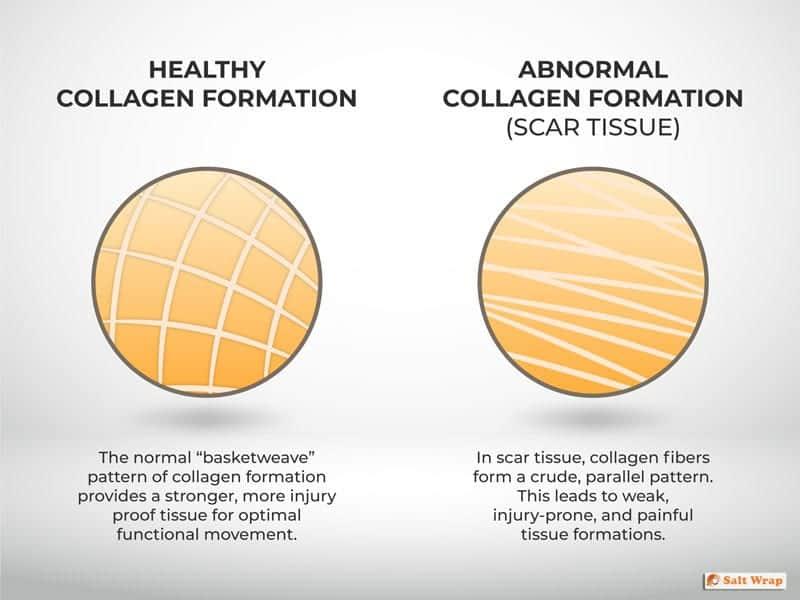
We see this a lot with clients suffering from tendinitis (inflammation of a tendon) that is becoming full blown tendinosis (degeneration of the tendon’s collagen base).
Because the client’s connective tissue has healed poorly, it’s weak and prone to minor tears.
This leads to a circular process of re-injury, inflammation, and tendinopathy.
Until the scar tissue is addressed and replaced with healthy cells, full recovery isn’t possible.
++
Technically speaking, an injury never fully recovers. There will always be an element of scar tissue and collagen malformation.
But the degree of this (how much it alters function and performance) can be affected with the proper injury recovery intervention steps.
That includes smart physical therapy, and smart nutrition.
The use of nutrients that stimulate collagen production and help optimize collagen tissue formation can be transformative during the injury repair process.
But it’s not as simple as loading up on collagen protein.
Research on injury repair, wound healing and surgical patients shows us that there is a specific type of collagen that works best for joint injuries.
And, there are other herbs and micronutrients that further support collagen production and synthesis at injury sites.
Here are the best supplements for collagen production and repair:
Collagen Protein
Collagen is the second most abundant substance in the human body, behind water.
And it’s the most abundant protein in the body, where it serves as the primary building block of tendons, bones and skin.
There are several types of collagen, but research shows upwards of 90% of the body’s collagen is made up of Types I, II and III.
Collagen protein supplements are also made up primarily of Types I and III.
Collagen protein goes my many names. Gelatin, hydrolyzed collagen, collagen peptides — they all refer to the same substance.
In addition to helping prevent age related wear and tear, relieve joint pain in athletes, and improve skin health — collagen protein supplements may also boost collagen synthesis in injured joint structures.
In a small placebo-controlled study, 5-15 grams of collagen protein enriched with Vitamin C doubled collagen synthesis versus the placebo group (measured by % of dry mass collagen).
Another study showed that 5 grams of collagen peptides significantly improved perceived function of injured ankle joints, and decreased ankle sprains and risk of ankle injuries after a three-month follow up period.
The recommended dosage of collagen protein for relieving joint discomfort and improving collagen synthesis is 5-15g per day.
Type II Collagen
Type II collagen (CII) is the primary component of joint cartilage, and the most bioavailable version when taken orally. Upwards of 90% of your body's extracellular matrix (mix of compounds that provide structural support to joints) is made of Type II collagen.
Supplementing with Type II collagen produces a novel effect in the body: it regulates the immune response responsible for inter-cartilaginous inflammation, which supports the overall healing process and helps manage pain levels.
Researchers believe that supplementing with Type II collagen stimulates the body to produce more of its own, along with other proteins that support the structure of joints and skin (elastin and fibrillin).
This collagen production process (along with the extra orally ingested collagen) provides more overall raw material to repair and rebuild connective tissues with.
Also, animal studies have shown that collagen may speed up the crucial granulation process that occurs during the first few days after an injury has occurred.
The clinically-supported minimum dosage for Type II Collagen is 40mg daily (Type II collagen is much more bioavailable than collagen protein which is made of mostly Types I and III. So a much smaller does is effective here.)
Curcumin (from Turmeric)
In addition to the antioxidant and inflammation benefits curcumin (turmeric) offers, it also aids in collagen production and collagen formation within the body.
A 2016 study published in Nutrition Journal described how in addition to its antioxidant properties, curcumin has "restored type II collagen and glycosaminoglycan synthesis" in subjects with knee pain.
Skin studies have mirrored this research, clearly showing that wounds treated with curcumin heal faster and produce stronger collagen formations (higher levels of collagen present in treated wounds).
It's also a potent natural pain reliever.
A small study of injured rugby players demonstrated that turmeric is more beneficial than NSAIDs and over the counter pain killers for injury recovery.
Still other research suggests curcumin mobilizes stem cells, which even surgical interventions for injury repair can’t offer.
Bottom line: curcumin is a powerhouse recovery supplement. And has earned its reputation as one of the most effective natural supplements in the world.
Though dosages as low as 200mg have proved beneficial for joint health, the recommended dosage to aid in the healing process and help manage inflammation is 1,000-1,500mg per day (for the first 2-3 weeks).
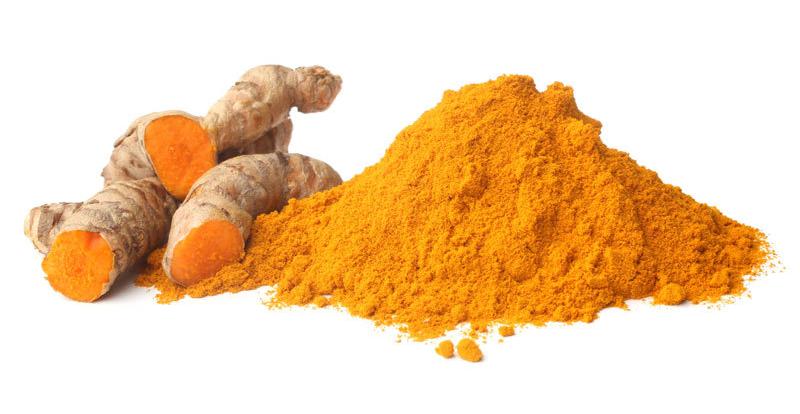
Turmeric supplements are made from grinding up the rhizomes of the Curcuma longa plant.
Vitamin C
Like curcumin, Vitamin C offers antioxidant potential and an additional benefit related to injury recovery: studies show that a Vitamin C deficiency leads to collagen fiber malformation — poorly structured fibers with weak tensile strength that are prone to re-injury.
Vitamin C supplementation after injury has the potential to accelerate joint and bone healing rates, increase type I collagen synthesis, and reduce post-injury oxidative stress levels.
Recommended dosages of Vitamin C for muscle recovery, immune support and injury repair are far above the RDI of 90mg per day.
Though studies have yet to prove that mega-doses of Vitamin C (2-5 grams per day) are beneficial — it does appear that taking 500-1000mg per day during recovery periods offers additional protection without added risk.
Hyaluronic Acid
One of the key components of injury recovery is tissue turnover (clean up and repair).
And though studies on hyaluronic acid for injuries and tissue damage are limited, it appears that hyaluronic acid plays a crucial role in the cell repair process by increasing turnover of extracellular matrix components (which includes collagen).
Although this does not prove efficacy in oral supplementation, hyaluronic acid injections have proved helpful for shoulder injury recovery.
Clinically supported dosages of Hyaluronic Acid range from 40-80mg per day. Because hyaluronic acid breaks down quickly in the digestive tract, consistent and longer term use is suggested.
Interesting Note: Studies show that Vitamin C further degrades hyaluronic acid when taken together — potentially by a 30-40% margin. This provides further support for taking a dosage on the higher end of the clinically supported spectrum (80mg per day). Otherwise, take these two supplements separately.
Green Tea
Green tea contains polyphenolic compounds that have antioxidant properties two to four times greater than Vitamin C.
And — though green tea consumption is not known to stimulate collagen production or improve collagen synthesis, it does suppress age-related collagen breakdown in animal models.
While studies are limited, we thought this benefit was unique enough to deserve a mention here — especially when you consider that green tea has a neuroprotective effect and supports cardiovascular health.
The recommended dosage for green tea extract supplementation is 1-2g per day.
Or, drink 2-3 cups of brewed green tea per day.
🔬 NSAIDs impair the healing process
Here’s another reason to look for natural alternatives to NSAIDs, pain killers, and other OTC pills: they impair the healing process. Animal studies have shown reduced collagen synthesis, reduced osteoclast (bone builder) cell activity, and deleterious effects on tendon healing.
And human studies show that NSAIDs increase rates of injury recurrence (due to weaker tissue formations).
- "The enthesis is the specialized junction between a tendon or ligament and bone..."
- "...animal studies have shown that overall, NSAIDs appear to inhibit proper enthesis repair..."
Our final injury supplement goal is the least sexy, but the most fundamental:
3. Provide the basic micronutrients your body needs to repair connective tissue.
Micronutrition — consumption of vitamins and minerals — is another overlooked aspect of injury repair protocols.
Just like how demand for antioxidants increases after an injury, demand for certain micronutrients increases as well.
Studies show that consuming these vitamins — sometimes in excess of the RDI (Reference Daily Intake) — is beneficial for injury recovery.
The RDI levels are only meant to prevent disease in the general population — they’re not designed to help repair injured joints, or even optimize health for people with greater demands of these nutrients.
Though the RDI serves as a useful and safe guideline, we looked at studies of specific micronutrients in clinically-effective dosages for injury recovery.
This list doesn’t encompass all nutrients your body needs, but instead focuses on those that are either most important or work well with an increased dosage after an injury:
🔬 What's the difference between RDA and RDI?
The acronyms are truly out of control. But such is life. As nutrition recommendations evolve, so do the fancy names. Here's what you need to know: the term RDA is basically obsolete, and we should be saying RDI when referring to amount of nutrients in our supplements and foods. The RDI really became relevant with the FDA's sweeping changes in 2016. We're still getting used to saying "RDI" instead of "RDA" -- like everyone else:
- RDA (Recommended Dietary Allowances): Set of nutrition recommendations developed by the FDA (technically outdated term). Should use "RDI" when referring to supplements.
- RDI (Reference Daily Intake): Daily intake level of a nutrient sufficient for the general population, dictates % Daily Value amounts listed on food labels. Derived from original RDA guidelines.
- % Daily Value: Labeling terminology -- percentage of RDI that the nutrients in a food or supplement occupy. Often used with RDI interchangeably when recommending nutrient intake.
- DRI (Dietary Reference Intake): System of nutrition recommendations that evolved from the RDA standards, but was developed by the Institute of Medicine of the National Academies. Since the FDA updated their nutrition recommendations in 2016, these differing recommendations are not as valuable. Again, let's stick to RDI.
- DRV (Daily Reference Value): Set of numerical values developed by FDA for intake of energy-containing macronutrients (e.g. fat, carbs, protein).
Vitamin A
Vitamin A supports healthy inflammation levels, immune function, and aids in the collagen formation process. Studies show that collagen formations are stronger with Vitamin A supplementation.
While going above the RDI doesn’t seem to offer any relevant additional benefit without risk of toxicity, getting 100% of your RDI is important.
Recommended Dosage: 900 mcg (1500 IU) of Vitamin A per day (100% RDI).
Though Vitamins A, D, and E have traditionally been measured in IU's (International Units), FDA guidelines now dictate they be listed in micrograms (mcg) on labels.
Vitamin C
Everyone has heard about popping extra vitamin C to help get over a cold. But studies show it also plays a vital role in collagen synthesis. In cases of vitamin C deficiencies, collagen fibers form sub-optimally with poor adhesion and tensile strength.
Studies show vitamin C supplementation supports optimal collagen formation, reduces exercise-induced oxidative stress, and provides antioxidant support for recovering joints and muscles.
Recommended Dosage: 1,000-1,500mg per day for the first 2-3 weeks post-injury, then at least 90mg per day going forward (100% Daily Value).
Vitamin D
Vitamin D helps maintain bone mineral density, skin health and even supports mood. Most people are not getting enough Vitamin D from diet and sun exposure alone, making this an important supplement for those who may be at risk of deficiency.
Studies show supplementing with Vitamin D improves joint comfort, mobility and strength in healthy subjects.
Recommended Dosage: 1,000-2,000 IU (25-50 mcg) per day during recovery periods [125% - 250% RDI]
Though this is well above the RDI, this dosage has demonstrated efficacy and safety in long-term studies.

🔬 Vitamin D Deficiency: Who is at risk?
Vitamin D insufficiency affects almost 50% of the population worldwide. The highest risk groups are breastfed infants, older adults, people with limited sun exposure, people with dark skin, people with fat malabsorption, and people who are obese or who have undergone gastric bypass surgery. And — you guessed it— people who have recently been injured are also at risk of being Vitamin D deficient. This is why nutrition researchers and sports physicians recommend Vitamin D supplementation to bolster the injury healing process and prevent future stress fractures and muscular injury.
Vitamin K
Vitamin K supports overall bone health, cardiovascular health, and is often taken in conjunction with Vitamin D for joint health.
Studies show supplementing with at least 100 mcg per day of Vitamin K results in better maintenance of bone mass.
Recommended Dosage: 120 mcg per day (100% RDI).
Chromium
Chromium plays a supportive role in producing energy from foods and maintaining bone mass.
Studies suggest chromium demand in the body increases during the first few days after injury, implying that supplementing with chromium during this time period may be beneficial for recovery.
Recommended Dosage: 200mcg per day (~570% RDI).
While this dosage range is far above the RDI, dosages below 200mcg have not shown consistent biological activity in studies.
Magnesium
Magnesium is one of the few micronutrients with the ability to reduce pain levels from supplementation. This is partially due to its muscle relaxing effects, and the role it plays in relationship to the pain receptor, NMDA.
Studies show supplementing with magnesium reduces pain levels, helps relax muscles and improves muscle oxygenation during periods of physical stress, and helps maintain bone mineral density.
Recommended Dosage: 200-400mg per day during recovery periods (50-100% RDI).
Manganese
Though often overlooked as a non-necessary dietary supplement, recent studies have demonstrated that manganese plays a role as a co-factor in the formation of cartilage, collagen, and bone mineralization.
Recommended Dosage: 2.3mg per day (100% RDI).
Zinc
Zinc is required for over 300 enzymatic activities in the body and plays roles in cell growth and repair, immune function and protein synthesis. Zinc is also lost through sweat, making it an important supplement for athletes.
Studies show supplementing with zinc increases glutathione production and antioxidant activity in athletes, helps keep inflammation in a healthy range, and supports joint and bone recovery processes.
Recommended Dosage: 30mg per day during recovery periods (~273% RDI), and 10mg per day going forward (100% RDI).
Tissue Specific Injuries
While joint related injuries occupy the lion’s share of total incidents, it’s worth looking at muscle and bone injuries separately since recovery goals are slightly different.
Muscle Injuries
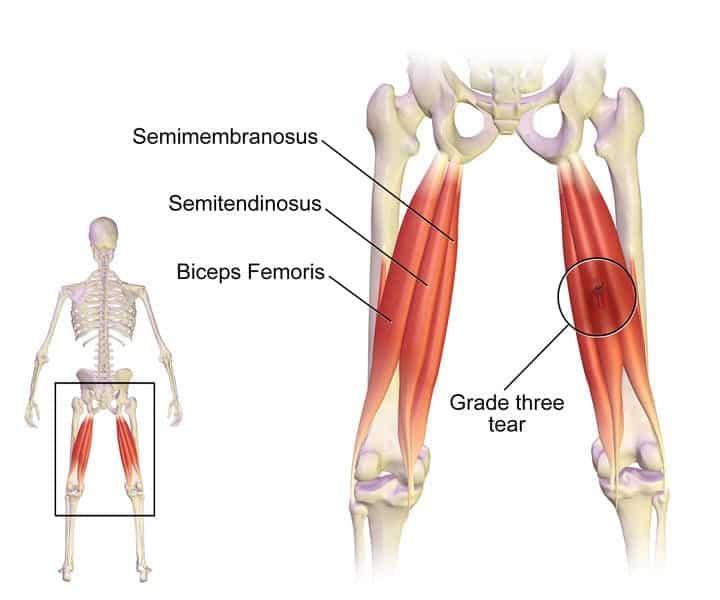
This diagram depicts a hamstring muscle tear — one of the most common sports muscle injuries. (Photo Credit BruceBlaus Pulled Hamstring title removed)
Muscle injuries are less common than joint injuries. In soccer, for example, only 31% of injuries are qualified as muscular. And they rarely exist as separate from connective tissue injuries.
Typically, the main site of an injury is the musculotendinous junction — where a tendon inserts into the muscle body.
Though it can occur in the middle of the muscle body, as depicted in the hamstring injury diagram above.
Also, most injuries have an overuse component.
Which almost always starts with the breakdown of connective tissue.
Still, it’s worth noting that musculoskeletal injuries have slightly different goals and recovery mechanisms than connective tissue injuries.
Collagen formation optimization may not be as important.
And in addition to the other goals we’ve already discussed, the following are more relevant:
- muscle damage markers
- muscle protein synthesis
- skeletal muscle atrophy
- muscle soreness
- muscle oxygenation
Keep in mind though — studies on NSAIDs for muscle injuries have shown reduced protein synthesis and muscle regeneration. So go easy on any supplements that suppress inflammation.
Here are a few proven supplements that will aid your muscle injury recovery efforts:
Muscle Protein Synthesis
As you can imagine, one of the main components of repairing a muscular injury is muscle protein synthesis — the process of assimilating proteins into new muscle tissue. So it stands that exercises and supplements that support that goal are a good idea during injury recovery periods:
Protein supplements: The injury repair process increases the body’s demand for dietary protein. Whether you get it from whole food or a supplement, it’s important to make sure you’re getting enough. After an injury, it’s common for an athlete’s total energy intake to decrease since their calorie requirements won’t be as high (as if they were training at full intensity and frequency).
If this describes you — and you keep your protein intake proportional as you eat less — then total protein intake decreases. Not good.
This could have deleterious effects on recovery even if you get “enough” protein according to recommended dietary allowance (0.8 g protein/day/kg BM).
A good solution is to increase your protein intake as a percentage of total calories, while getting fewer calories from fat and carbohydrates.
Shoot for 1g of protein per pound of body weight (daily) during injury recovery periods.
Essential Amino Acids (EAAs): Supplementing with a blend of Essential Amino Acids reduces muscle loss during periods of recovery (lower exercise intensity or complete rest). This may be attributed to the branched-chain amino acid leucine, as it plays a primary role in protein synthesis.
But supplementing with high doses of leucine has negative side effects, and it appears that the presence of the other essential amino acids is important for utilization of any one.
The same goes for the ever popular BCAA supplement (Branched-Chain Amino Acids) which includes only three amino acids: leucine, isoleucine, and valine. Research indicates other EAAs need to be present to get the muscle-building benefits.
If you want to boost muscle protein synthesis and reduce muscle loss, supplement with 5-10g daily of Essential Amino Acids instead of other individual supplements or blends (or, just make sure you’re getting enough protein from food.).
Creatine Monohydrate: Creatine monohydrate is not only one of the most proven sports nutrition supplements available, it has research specifically applicable to injury recovery. Creatine use appears to stimulate muscle hypertrophy during rehabilitative strength training, making this a smart option for post-injury rehab. The recommended dosage is 5g creatine monohydrate daily.
Muscle Damage, Clean Up and Repair
HMB: A metabolite of the amino acid leucine, HMB is short for β-Hydroxy β-Methylbutyrate. In supplement form, HMB reduces muscle damage markers. A dosage of 1-3g daily is recommended during recovery periods.
L-Carnitine: This amino acid reduces muscle damage and related oxidation and improves muscle oxygenation when taken in its various forms. It also has an anti-fatigue effect that some find useful as an ergogenic aid. The recommended dosage is 1-2g daily of L-carnitine L-tartrate.
Serrapeptase: Serrapeptase is an protein-degrading enzyme derived from silkworms. The origin of this enzyme sounds too wonky to be true. But it has solid research backing for reducing pain, inflammation and swelling following surgery. The recommended dosage is 30-60mg per day.
Antioxidants for Muscle Repair
CoQ10: We already discussed how CoQ10 supports recovery processes via antioxidant action and reducing exercise-induced tissue damage — but its worth mentioning here again for its ability to reduce markers of muscle damage in exercise-trained men. The recommended dosage is 90mg per day.
Bromelain: Bromelain is an enzyme derived from pineapple that helps break down protein. When ingested, bromelain supports the immune response by promoting production of natural substances that help maintain healthy levels of inflammation and swelling. Bromelain may also be beneficial for muscle soreness.
Grape Seed Extract: In addition to being a well-established antioxidant and circulation booster, animal studies suggest grape seed may help prevent post-traumatic tissue damage.
Tart Cherry Extract: Known for its ability to help gout patients get their uric acid levels down naturally, tart cherry also helps reduce muscle injury biomarkers and reduce muscle pain from exercise. A commonly used dosage is 10-20 ounces of juice, or 1 gram of freeze dried extract per day.
Bone Injuries & Fractures
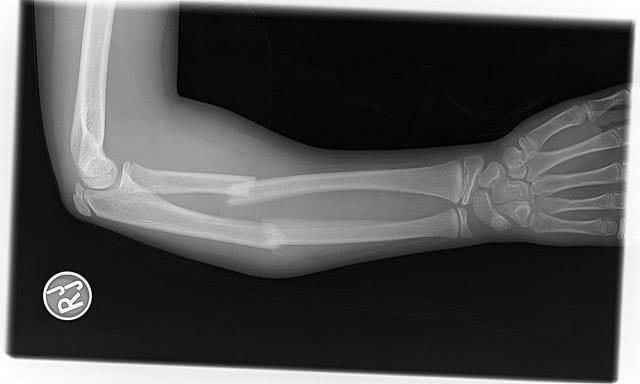
Photo credit: Broken Arm X-Ray: fractures of the ulna and radius bones (Photo Credit: Craig Allen)
For bone injuries, it's best to avoid anti-inflammatory supplements for the first few months.
That's because research shows NSAIDs suppress prostaglandins, which are crucial to the bone formation process.
Though research on inflammation-modulating supplements for bone injuries is more sparse, the safe bet is to avoid them.
Here a few other supplements that can aid bone injury recovery:
Calcium: The demand for calcium increases after a bone fracture. Though we normally don’t recommend that healthy, active people supplement with calcium because the RDI of 1,300mg can be easily attained from food alone — it may make sense to add a calcium supplement dependent upon your diet. The recommended intake for calcium for the first 2-6 weeks post-injury is 1,500mg per day.
Rule of Thumb: Each serving of dairy contains around 300mg of calcium. So, if you consume 2 cups of milk, one serving of cheese, 2-3 servings of leafy greens, plus some whole wheat products over the course of a day — you do not need to supplement with calcium. If your diet lacks these foods then supplementing with an additional 500-1000mg during the post-injury phase is a best practice.
Vitamin K: Vitamin K (specifically, K2) allows osteo-calcin to draw calcium into the bones. So adequate Vitamin K intake is necessary to ensure your body can metabolize calcium for bone repair. Studies show supplementing with at least 100 mcg per day of Vitamin K results in better maintenance of bone mass.
Recommended Dosage: 120 mcg per day (100% RDI).
Vitamin D: Your body needs Vitamin D to absorb calcium as well.
Recommended Dosage: 1,000-2,000 IU (25-50 mcg) per day during recovery periods [125% - 250% RDI]
Cissus: Cissus deserves another mention here for its unique ability to stimulate bone-building osteoblast cells. Also, cissus combined with calcium seems to offer additional bone-building support, as this combination has outperformed the placebo in studies measuring fracture healing rates.
Recommended Dosage: 3,200mg per day during post-injury recovery periods.
All-Stars: The Most Research-Backed Supplements for Injury Recovery
Even though we narrowed down the list of antioxidants, joint supplements, and micronutrients to those most relevant to injury — it’s still an extensive list.
It's simply not practical to take the recommended dosages for everything referenced in this guide.
This list below highlights the all-stars: ingredients with the most research backing, and those that cross over multiple injury recovery goals.
If you want to optimize the quality of your injury recovery, and help speed up the process, focus on these top performers:
Curcumin
In head-to-head studies, turmeric outperforms ibuprofen for joint pain and function scores (while presenting far fewer negative side effects).
Not only does turmeric reduce oxidative stress via its antioxidant effects, it reduces inflammation in osteo-cartilagenous tissue. And animal models demonstrate that curcumin can help regenerate damaged nerves after injury.
One placebo-controlled human study showed that joint stiffness improved by 86%, and subjective pain levels improved 40% in just 6 weeks.
Studies show that wounds treated with curcumin heal faster and produce stronger collagen formations (higher levels of collagen present in treated wounds). And animal models demonstrate that curcumin can help regenerate damaged nerves after injury.
As you can see, curcumin optimizes nearly every facet of the repair process.
Dosages of 200mg to 1500mg have been proven safe and effective for pain relief, joint function, and overall inflammation.
Pro Tip: Take black pepper extract (piperine) with your turmeric – studies on animals and humans have shown a 2,000% increase (20X) in absorption when turmeric is combined with black pepper extract.
Cissus
Cissus is one of the few herbs proven to improve joint function in athletes, reducing joint pain in healthy subjects by 31%. While cissus is most notably referenced for its ability to stimulate bone-building osteoblast cells, it also possesses antioxidant properties.
Cissus' unique bone-building, joint-supporting effects make it a top performing post-injury supplement.
While 300mg per day appears to have benefits related to inflammation and metabolism, the most relevant study for joint injuries used a dosage of 3,200mg per day for 8 weeks.
Grape Seed Extract
In addition to supporting healthy circulation, grape seed extract is an effective supplement for reducing inflammation from overtraining and reducing total body oxidation.
Subjects in one study had 38% lower C-Reactive Protein (CRP) levels, a measure of inflammation, after taking grape seed extract.
Another study showed that grape seed extract reduces swelling by up to 70% (in subjects who had swelling from prolonged periods of sitting).
Grape seed has also been combined with olive extract in animal studies for preventing post-traumatic tissue damage, indicating that use of grape seed may help prevent injuries from causing degenerative joint conditions later in life.
Clinically-supported dosages of grape seed extract range from 150-300mg per day (comprised of at least 95% total polyphenols).
L-Carnitine
This amino acid reduces muscle damage and related oxidation and improves muscle oxygenation when taken in its various forms. It also has an anti-fatigue effect that some find useful as an ergogenic aid.
The recommended dosage is 1-2g daily of L-carnitine L-tartrate.
HMB
A metabolite of the amino acid leucine, HMB is short for β-Hydroxy β-Methylbutyrate. In supplement form, HMB reduces muscle damage markers.
A 1-3g dosage is recommended during muscle injury recovery periods.
CoQ10
CoQ10 reduces exercise-induced oxidative stress and reduces exercise-induced tissue injuries in athletes, largely due to its antioxidant properties.
The clinically-supported dosage for CoQ10 ranges from 90-200mg per day (must be taken with food).
Because CoQ10 is a relatively expensive ingredient and 200mg provides only marginal increases in efficacy, 90mg per day is the recommended dosage.
Vitamin C
Vitamin C supplementation after injury has the potential to accelerate joint and bone healing rates, increase type I collagen synthesis, and reduce post-injury oxidative stress levels.
Recommended dosages of Vitamin C for muscle recovery, immune support and injury repair are far above the RDI of 90mg per day. Though studies have yet to prove that mega-doses of Vitamin C (2-5 grams per day) are beneficial — it does appear that taking 500-1000mg per day during recovery periods offers additional protection without added risk.
Type II Collagen
Supplementing with Type II collagen produces a novel effect in the body: it regulates the immune response responsible for intercartilaginous inflammation, which supports the overall healing process and helps manage pain levels.
Researchers believe that supplementing with Type II collagen stimulates the body to produce more of its own, along with other proteins that support the structure of joints and skin (elastin and fibrillin)
Also, animal studies have shown that collagen may speed up the crucial granulation process that occurs during the first few days after an injury has occurred.
The recommended dosage for Type II Collagen is at least 40mg daily.
Supplements to Avoid After Injury
Vitamin E
Though Vitamin E provides antioxidant potential when taken orally, it may slow the healing process. Studies on topical Vitamin E products have demonstrated slowed healing, and because of its effect on the clotting process it may slow the healing of connective tissue injuries as well.
Sodium
Ok, so you’re probably not going to supplement with extra salt. Although some endurance athletes do. But you may end up eating salt-laden junk foods, which could cause excessive excretion of calcium, which can slow joint and bone healing.
Caffeine
In vitro studies show caffeine intake inhibits collagen biosynthesis in a dose-dependent manner. Which sounds bad for injury healing.
Does that mean you should give up your morning coffee?
No, no need for that. Research shows intake in excess of 300mg per day in correlated with increased risk of fracture and joint degradation, but a cup or two of coffee won't slow you down.
Best practice: limit caffeine intake to 300mg or less during first 6 weeks of recovery. That means you can still have 2-3 cups of coffee per day. Just don’t overdo it and disturb your sleep. You’re going to need some shuteye if you plan on a speedy (and optimal) recovery.
Excessive use inflammation-modulating supplements
Remember that inflammation is a necessary part of injury repair.
Especially in the first few weeks.
So don't take a medicine cabinet full of anti-inflammation supplements just to quash inflammation.
Instead, focus on those few nutrients (e.g. cissus, turmeric) with other recovery-boosting properties.
Excessive use of pain killers
While pain relief is a secondary benefit of many of the ingredients we discuss in this guide, pain is an important signal.
By blocking pain sensations, you may be opening yourself to further injury.
If something hurts, don't just mask it. Listen to what your body is telling you and takes steps to address the underlying problem.
Avoid excessive use of OTC pain killers and other supplements designed specifically for pain relief (that don't have other injury-related benefits).
We cut through the maze of recovery supplements so you don't have to.
The Best Supplement for Total Joint Recovery
There’s no supplement, herb or magical potion that can pop your dislocated shoulder back into the socket or fix your broken arm.
But there are nutrients that support your body’s natural joint and connective tissue recovery processes.
While this guide gives you a jumping-off point for assembling your own joint-recovery cocktail, we wanted to take it a step further.
So we assembled the most research-backed, joint-building, natural ingredients into one protocol.
It’s called Joint Clinic.
Joint Clinic is unlike any other recovery product available:
- It contains ingredients proven to support your body’s natural connective tissue recovery processes, including collagen synthesis.
- It uses the TaperSmart™ dosage schedule — weaning you off the formula and allowing your body’s immune and cell turnover processes to take over (without the rebound effects that can happen when you stop a program cold turkey).
Learn more about Joint Clinic here.
Conclusion
Keep NSAID usage to a minimum following an injury.
Though they may relieve your pain in the short-term, long-term studies tell a different story.
You're better off using natural supplements to modulate pain and inflammation.
And make sure you’re getting enough of the joint-specific micronutrients (vitamins and minerals) covered in this guide.
You can accomplish this by eating a diet that is high and varied in fruits and vegetables — but it’s tough to ensure you’re optimizing intake without using supplements.
Especially for nutrients like Vitamin C that we recommend taking in dosages well above the RDI.
It’s also vital to ensure you aren’t causing more damage to the injury.
By supplementing with nutrients that aid your body’s natural immune, inflammation, and cell turnover processes — you can optimize your body’s immune response while preventing further damage caused by free radicals and high inflammation.
And remember, while it’s a good idea to seek professional help, you also have to be your own advocate.
No one knows your body quite like you do.
By understanding and utilizing exercise therapy best practices, intelligent rest, and sound nutrition — you can give your joints and muscles a considerable advantage in the battle against acute and overuse injuries.
But again... be smart! Supplements aren't going to fix your broken wing.
If you think you need medical attention, you probably do.
Use this list to determine if you should seek medical attention for your injury:
When to seek medical attention
- Abnormal bone, joint, or muscle positioning (e.g. it looks crooked or is misshapen)
- Excessive swelling, bruising, bleeding
- Sharp pain when performing previously pain-free movements
- Inability to bear weight on the limb or joint without it giving way
- A feeling of abnormal “looseness” in the joint
Medical Disclaimer: Nothing contained on this site is intended to diagnose or cure. Should you have any health care related questions, please contact your physician. You should always consult your physician before taking any nutritional supplements, making changes to your health or fitness regimens, or implementing any health related advice. See full disclaimer here.
Founder: Scott Hogan

I created SaltWrap to bring together the most practical ideas in therapeutic sports nutrition, corrective exercise, and functional fitness — with the goal of keeping you (and myself) strong, mobile, and built to last.
I've worked as an A.C.E. Certified Personal Trainer, Orthopedic Exercise Specialist, and nutritional supplement formulator.
But more importantly — I've spent most of my life battling injuries, joint pain, and just being plain beat up. So I know what it's like to struggle toward fitness goals.
SaltWrap is here to push you through injuries, setbacks and perceived physical limitations. To a place beyond what you think you're capable of. Sign up here to stay in the loop.
Learn more about my best-selling injury prevention and recovery book, Built from Broken.

